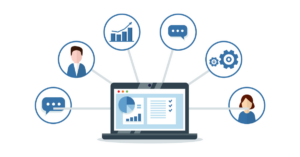Manufacturing companies aren’t typically on the leading edge of adoption for digital marketing strategies, and according to the Content Marketing Institute, only 1% of manufacturing marketing teams consider their marketing to be “sophisticated”. However, you don’t need to be a marketing wizard to leverage your CRM data to efficiently (and effectively) segment, nurture and ultimately sell more deals with your marketing automation platform. You just need the right data and a plan in place.
Marketing deserves at least a 50% stake in every CRM. The data being collected in your company’s CRM is invaluable to your marketing efforts and can be used to power lead nurtures, re-engagement campaigns, custom audiences, cross-sell campaigns, upsell campaigns, customer retention strategies, review strategies and insight into what’s working and what’s not working. But without a plan, the data you’re collecting is meaningless. To implement a data-driven marketing strategy, you should spend some time mapping your ideal customer journey. To do this, you will want to walk your teams through each stage of your customer journey (awareness, consideration, convert, loyalty, and advocacy) and use the conversation to identify points where marketing can support the sales and customer success process along the way.
To help you map your customer journey, you can download our Customer Journey Worksheet here.
When you’re finished mapping your customer journey, you will want to identify the different data points you will need to target and personalize your campaigns and figure out how you are going to get them. For example:

Learn how you can leverage the data in your CRM with the emfluence Marketing Platform’s integration to Microsoft Dynamics and Salesforce.
Once you’ve devised a plan and gotten your data in order, you will be ready to use that data to launch some highly targeted campaigns. To get started, here are five campaigns you should be running with real-life examples:
Nurture Campaigns for MQLs
If you aren’t already, you should be segmenting your leads into two categories: marketing qualified and sales qualified. A marketing qualified lead is someone who has given you their contact information by downloading a piece of your content, registering for a webinar, signing up to receive your newsletters or stopping by your booth at a tradeshow, but hasn’t reached out directly to your sales team to learn more about your product(s). A sales qualified lead is someone who has expressed buyer intent by filling out a form on your website, contacting your sales team directly or by reaching a certain level of engagement (or high contact score).
The goal of a nurture campaign is to reach out to those who aren’t sales ready to establish trust and nurture them until they reach a point where they are deemed sales ready. Your nurture campaign should act as a follow-up whenever someone downloads a case study, spec sheet, whitepaper, etc.
Data points to map from your CRM to your marketing automation platform:
- Prospect Name – for personalization
- Company Name – for personalization and ABM segmentation
- Region, Territory or Zip Code – for segmentation and dynamic content
Here is an example of a nurture series from Tension Envelope, a leader in envelope and packaging solutions that sells directly to businesses and organizations nationwide:

Learn how to build a whitepaper download nurture campaign in the emfluence Marketing Platform.
Don’t be afraid to get creative! Tnemec Company, a leading manufacturer of coatings and coating systems for exterior and interior environments, runs a contest every year called Tank of the Year. Since 2006, Tnemec has named a Tank of the Year from hundreds of nominated water tanks from around the country. Tank of the Year winners are true testaments to the creative and innovative uses of Tnemec coatings. What was once a small thank you campaign has become a true brand awareness contest engaging a wide range of community members.

Newsletters to Nurture
An effective newsletter is an extremely valuable marketing tool that can go a long way in educating and persuading your clients and prospects to work with you. They help keep your brand top-of-mind for consumers, establish credibility and authority and notify readers of products and company news that may be of interest to them. To be effective, your newsletters should contain the following six elements:
- Good content marketing
- A segmented audience (If your brand has several different divisions, product lines, etc. consider creating different newsletters for each one)
- Strong subject lines
- Visually appealing templates
- Your company’s contact and social media information
- Call to action
Data points to map from your CRM to your marketing automation platform:
- Subscriber’s Name – for personalization
- Company Name – for personalization and ABM segmentation
- Region, Territory or Zip Code – for segmentation and dynamic content
Note: These newsletters should only be sent to contacts who opt in to receive them. Make sure you include a form on your website where visitors can sign up, as well as a landing page for signups that you can link to in your other email communications.
Here are a couple of examples from Tension Envelope:

Learn how to plan your email newsletter strategy in the emfluence Marketing Platform.
SQL to Opportunity
To turn a sales qualified lead into an opportunity, it’s important to craft campaigns that can help gauge buyer intent. As part of these campaigns, you should be sending emails with clear calls to action, such as a link to watch a video, download a catalog, shop on your website, schedule time to chat with a sales rep, etc. As you run these campaigns, you can then pay attention to contact score to see who is the most engaged and have sales reach out to them when they reach a pre-determined threshold.
Data points to map from your CRM to your marketing automation platform:
- Customer’s Name – for personalization
- Company Name – for personalization and ABM segmentation
- Contact Score – for segmentation
- Website Page Visits – for segmentation and dynamic content
- Area of Interest – for dynamic content
Here are a couple of examples from Mid-America Fittings, a leading manufacturer of engineered, industrial grade brass fittings, valves and custom components used by OEM’s and industrial and plumbing wholesale distributors:

Learn how to use buyer intent signals to automate outreach in the emfluence Marketing Platform.
Account Onboarding
Part of retaining clients is keeping them engaged, and a great way to do that is with an account onboarding series. This should be an automated series that you can drop customers into as soon as they place an order or open an account. The email series should include things like instructions on how to place an order, information about different services or products you offer, a link to where they can request a quote, and other resources that will ensure they have a positive experience with your company.
Data points to map from your CRM to your marketing automation platform:
- Sales Rep – for personalization (direct outreach from an assigned rep)
- Customer’s Name – for personalization
- Company Name – for personalization and ABM segmentation
- Purchase History – for segmentation and dynamic content
- Opportunity Win Date – for segmentation and dynamic message timing
Below are a couple of examples from Midland Industries, a family of brands that manufactures more than 40,000 products used in the plumbing, PVF, waterworks and irrigation industries. They also offer marketing, order gathering and shipping tools to help their clients expand and grow their businesses.

You can also automate notifications about new clients to sales reps and emails that urge customers to open an account after they’ve purchased one of your products or used a tool on your website. See how YRC Freight, the largest subsidiary of YRC Worldwide, uses these tactics in the following examples:

New Product Release
A new product release series is the perfect way to cross-sell, upsell or earn new business. Every time your company launched a new product, you should be sending a series of informational emails about the product with links to an informational sheet, catalog page, a full catalog download, etc. It’s also a great time to ask your customers and newsletter subscribers to update their preferences.
Data points to map from your CRM to your marketing automation platform:
- Previous purchase history – for segmentation and dynamic content
- Purchase “gaps” (indicating where they sourced the product elsewhere) – for dynamic message timing
- Opportunity win date – for dynamic message timing
Here are a couple of examples from Midland Industries where they are promoting a new product, as well as showing a customer recommended products and asking for their feedback:

Learn how to build a cross sell campaign in the emfluence Marketing Platform.
Need some help with your email strategy or marketing automation? Reach out to us at expert@emfluence.com.


